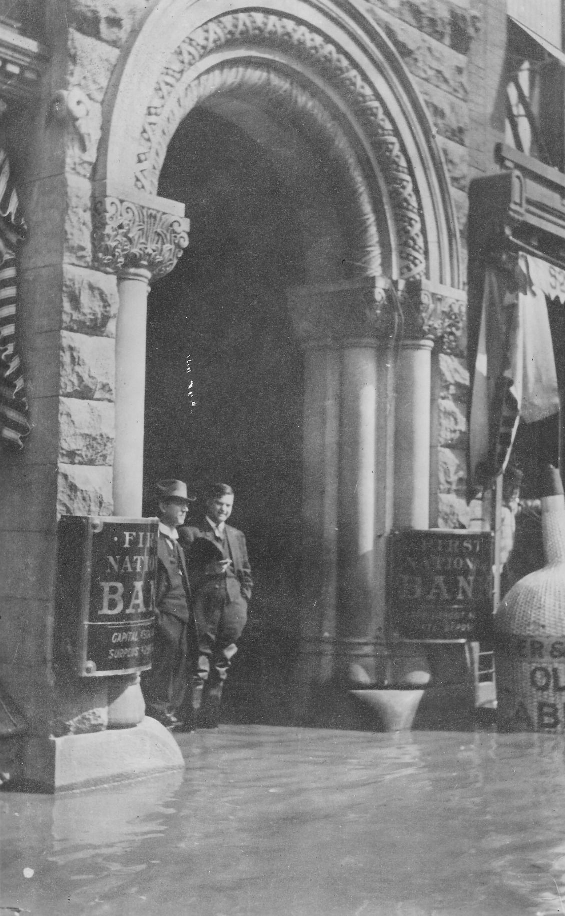The First National Bank
------------------------------------------------------------------------------------------------------

When it open in 1884 the First National Bank stood on the
current site of Pullman Square.
------------------------------------------------------------------------------------------------------
The first
bank to open in the new town of Huntington was the Bank of Huntington. Chartered
in July of 1875,
it was housed in a small brick building on the north side of
3rd Avenue just east of 12th Street.
Peter Cline Buffington, the first mayor of
Huntington, was the bank's president. Shortly after it opened,
on Sept. 6, 1875, the bank was the scene of a daring holdup. Local legend says the robbery was the
work of famed outlaw Jesse James and his gang, but most historians doubt that
claim. When
Heritage Village opened in 1967, the historic bank building was
moved there.
In 1884, a
group of Huntington investors opened the town's second bank, the First National
Bank
of Huntington. The new bank was housed in a stone building erected at 926
3rd Ave, the current site
of Pullman Square. The bank is shown here in a vintage
postcard photograph taken during the
1913 flood. The two men standing in the
doorway, looking at the flooded street, are unidentified.
The First
National, it might be noted, was conveniently located next door to one of the
city's most popular saloons, Ziegler & Behrend. A straw demijohn advertising the
saloon can be seen at the right of the photo.
J.L. Caldwell
was elected president of the new bank, a post he would hold
until his death in
1923. A commanding figure in the early history of Hunting the
Guyan Valley coal
fields and the building of the Guyan Valley branch of the
Chesapeake & Ohio
Railway, which linked the coal fields with Huntington.
George F.
Miller Jr. was elected executive vice president of the new bank, a role he
would
fill until his death in 1910. Like Caldwell, Miller was a prominent
figure in
the city's early business community.
The First
National grew with the city and prospered. In 1912, it purchased a lot on the
southwest corner of 4th Avenue and 10th Street and there erected a 12-story
building
that would become one of downtown Huntington's best-known landmarks.
Today,
the building provides a downtown presence for the First State Bank of
Barboursville.
Editor's
note: This is the 63rd in a series of articles recalling vanished Huntington
landmarks.
The first
bank to open in the new town of Huntington was the Bank of Huntington.
Chartered in
July of 1875, it was housed in a small brick building on the
north side of 3rd Avenue just east
of 12th Street. Peter Cline Buffington, the
first mayor of Huntington, was the bank's president.
Shortly after it opened, on Sept. 6, 1875, the bank was the scene of a daring holdup.
Local legend says
the robbery was the work of famed outlaw Jesse James and his
gang, but most
historians doubt that claim. When Heritage Village opened
in 1967, the
historic bank building was moved there.
In 1884, a
group of Huntington investors opened the town's second bank, the First
National Bank
of Huntington. The new bank was housed in a stone building
erected at 926 3rd Ave, the
current site of Pullman Square. The bank is shown
here in a vintage postcard
photograph taken during the 1913 flood. The two men
standing in
the doorway, looking at the flooded street, are unidentified.
The First
National, it might be noted, was conveniently located next door to one of
the
city's most popular saloons, Ziegler & Behrend. A straw demijohn
advertising
the saloon can be seen at the right of the photo.
J.L.
Caldwell was elected president of the new bank, a post he would hold until his
death in 1923. A
commanding figure in the early history of Hunting the Guyan
Valley coal fields and the building of the
Guyan Valley branch of the
Chesapeake & Ohio Railway, which linked the coal fields with Huntington.
George F.
Miller Jr. was elected executive vice president of the new bank, a role he
would fill until
his death in 1910. Like Caldwell, Miller was a prominent
figure in the city's early business community.
The First
National grew with the city and prospered. In 1912, it purchased a lot on the
southwest
corner of 4th Avenue and 10th Street and there erected a 12-story
building that would become
one of downtown Huntington's best-known landmarks.
Today, the building provides
a downtown presence for the First State Bank of
Barboursville.
-----------------------------------------------------------
Note: This Article and picture appeared in the
Herald-Dispatch Newspaper on Jun. 15 , 2015
-----------------------------------------------------------
[ Back ]
